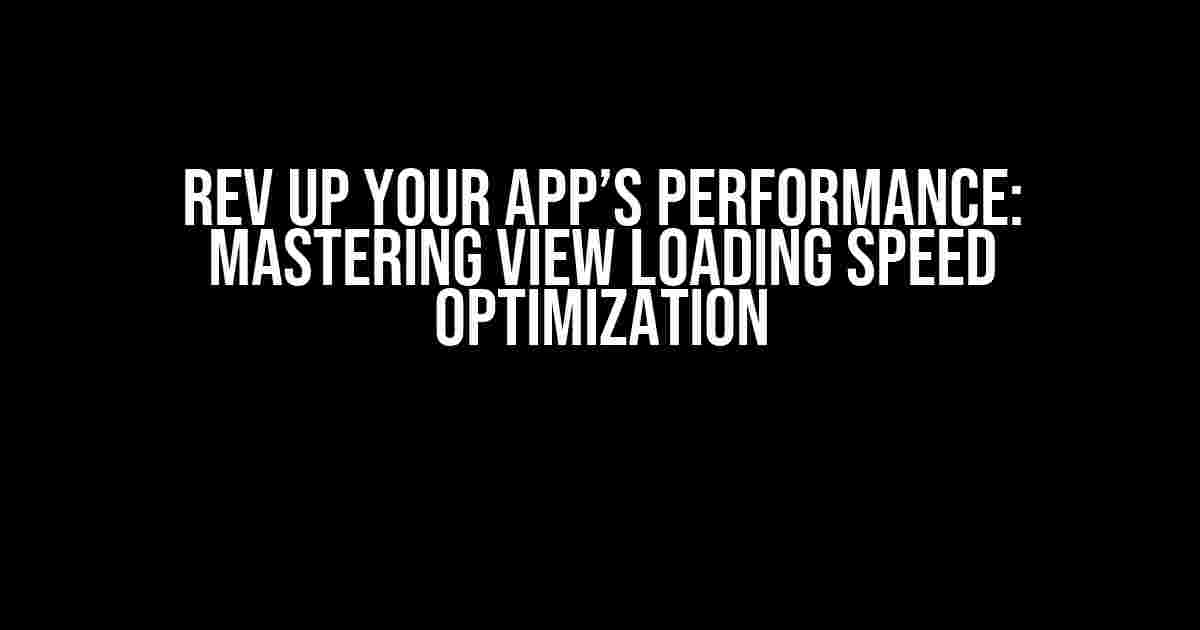Are you tired of frustrated users abandoning your app due to slow loading times? Do you want to provide a seamless user experience that leaves a lasting impression? Look no further! In this article, we’ll dive into the world of view loading speed optimization, specifically tackling the pesky issue of custom view reuse leading to too many inflates, resulting in sluggish view loading.
Understanding the Problem: Custom View Reuse and Inflates
When it comes to building complex UIs, custom views are often the go-to solution. However, when not implemented carefully, these custom views can quickly become the bottleneck that slows down your app’s loading speed. The root of the issue lies in the inflate process.
During the inflate process, Android creates a new instance of the view and sets its layout parameters. This process can be costly, especially when dealing with complex views or large datasets. When you reuse custom views, you’re essentially re-inflating them, leading to a performance hit.
The Consequences of Excessive Inflates
- Slow View Loading: Re-inflating views takes time, causing your app to lag and stutter, leading to a subpar user experience.
- Increased Memory Usage: Multiple inflates result in increased memory allocation, which can lead to memory leaks and even crashes.
- Reduced Battery Life: The excessive CPU cycles required for inflates drain the battery, reducing the overall battery life.
Optimizing View Loading Speed: Strategies and Techniques
Fortunately, there are several strategies and techniques to mitigate the performance impact of custom view reuse and excessive inflates.
1. Use ViewHolders
A ViewHolder is a design pattern that allows you to cache views and reduce the number of inflates. By using a ViewHolder, you can:
- Re-use views instead of re-inflating them.
- Reduce memory allocation and garbage collection.
- Improve view loading speed and overall performance.
public class MyViewHolder extends RecyclerView.ViewHolder {
public TextView textView;
public MyViewHolder(View itemView) {
super(itemView);
textView = itemView.findViewById(R.id.text_view);
}
}
2. Recycling Views
Recycling views is a technique that allows you to re-use views that are no longer visible. By recycling views, you can:
- Reduce the number of inflates.
- Improve view loading speed and performance.
- Decrease memory allocation and garbage collection.
public class MyAdapter extends RecyclerView.Adapter {
@Override
public MyViewHolder onCreateViewHolder(ViewGroup parent, int viewType) {
View view = LayoutInflater.from(parent.getContext()).inflate(R.layout.my_layout, parent, false);
return new MyViewHolder(view);
}
@Override
public void onBindViewHolder(MyViewHolder holder, int position) {
// Bind data to the view holder
}
@Override
public void onViewRecycled(MyViewHolder holder) {
super.onViewRecycled(holder);
// Clear the view holder's resources
}
}
3. Using a View Pool
A View Pool is a mechanism that allows you to re-use views that are no longer visible. By using a View Pool, you can:
- Reduce the number of inflates.
- Improve view loading speed and performance.
- Decrease memory allocation and garbage collection.
public class MyViewPool {
private final LinkedList views = new LinkedList<>();
public View getViews() {
View view = views.poll();
if (view == null) {
view = LayoutInflater.from(context).inflate(R.layout.my_layout, null);
}
return view;
}
public void returnView(View view) {
views.add(view);
}
}
4. Optimizing Layout Inflation
Layout inflation is a costly process that can slow down your app’s loading speed. To optimize layout inflation:
- Use a single layout file for each view type.
- Avoid deep hierarchies and complex layouts.
- Use lazy loading for non-essential views.
5. Profiling and Benchmarking
Profiling and benchmarking are essential tools for identifying performance bottlenecks in your app. By using tools like the Android Debug Bridge (ADB) and the Android Studio Profiler, you can:
- Identify slow-performing views and layouts.
- Measure the performance impact of custom views and inflates.
- Optimize view loading speed and overall performance.
| Tool | Description |
|---|---|
| Android Debug Bridge (ADB) | Provides a command-line interface for debugging and profiling Android apps. |
| Android Studio Profiler | Allows you to profile and debug Android apps, providing detailed insights into performance, memory, and CPU usage. |
Conclusion
In conclusion, optimizing view loading speed is crucial for providing a seamless user experience. By understanding the impact of custom view reuse and excessive inflates, and implementing strategies like ViewHolders, recycling views, View Pools, optimizing layout inflation, and profiling and benchmarking, you can significantly improve your app’s performance.
Remember, every millisecond counts, and a well-optimized app can make all the difference in user satisfaction and retention. So, what are you waiting for? Get started on optimizing your app’s view loading speed today!
Keywords: View loading speed optimization, custom view reuse, too many inflates, slow view loading, Android performance optimization, ViewHolders, recycling views, View Pools, layout inflation, profiling, benchmarking.
Frequently Asked Question
Get the inside scoop on view loading speed optimization and custom view reuse!
What is custom view reuse, and why does it affect view loading speed?
Custom view reuse is a technique where you use a custom view instead of the default view provided by the system. While it can be beneficial for performance, it can also lead to too many inflates, ultimately slowing down view loading speeds. This happens because every time a custom view is reused, it needs to be inflated again, which consumes system resources and time.
Why do too many inflates slow down view loading speed?
Too many inflates slow down view loading speed because they require the system to parse the XML layout, create objects, and set properties. This process consumes CPU resources, leading to slower loading times. Additionally, if you’re using complex layouts or many views, the inflation process can become even more resource-intensive, further slowing down view loading speeds.
How can I optimize custom view reuse for faster view loading speeds?
To optimize custom view reuse, you can implement view holder patterns, which reduce the number of inflates by reusing views instead of inflating new ones. You can also use caching mechanisms to store and retrieve pre-inflated views, reducing the need for frequent inflations. Additionally, consider using lightweight views and simplifying your layout hierarchy to reduce the load on the system.
What are some best practices for custom view reuse?
Some best practices for custom view reuse include using a single, reusable view instead of multiple instances, minimizing the number of inflates, and avoiding complex layouts. You should also consider using a view pool to manage and reuse views, and implement lazy loading to delay the inflation of views until they’re actually needed.
Are there any tools or libraries that can help me optimize view loading speeds?
Yes! There are several tools and libraries that can help you optimize view loading speeds. For example, Android Studio’s built-in Layout Inspector can help you identify performance bottlenecks, while libraries like RecyclerView and ListView can help you implement efficient view reuse. You can also use profiling tools like Android Debug Bridge (ADB) and the Android NDK to identify performance issues and optimize your app’s performance.



